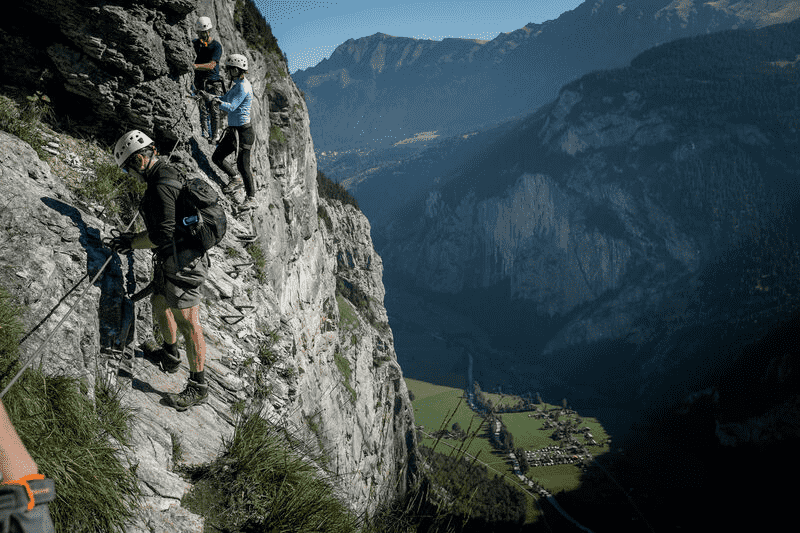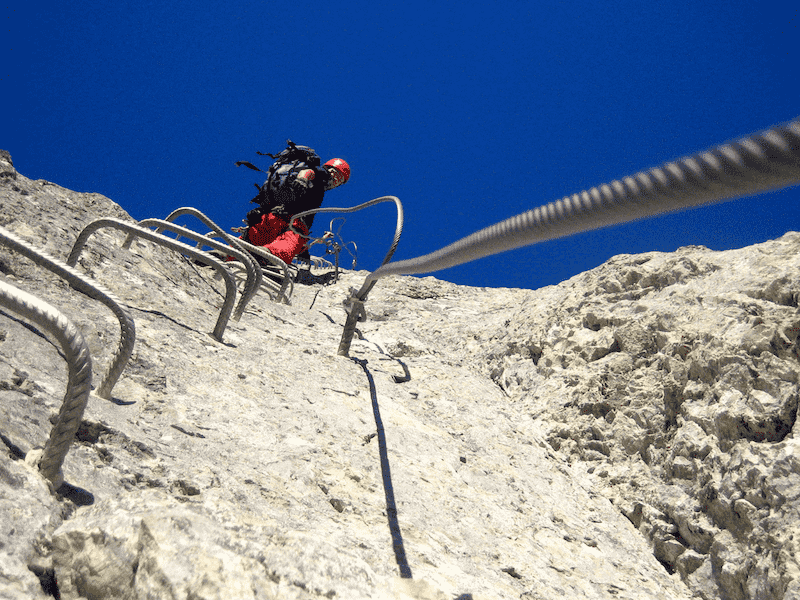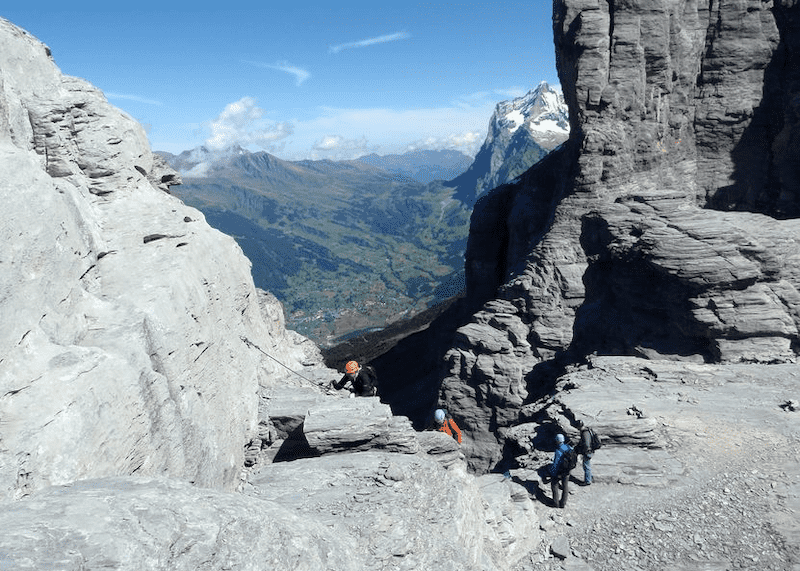Have you ever heard of via ferrata? Via ferrata isn’t new. The term is Italian for “iron way,” and the technique was used by Italian soldiers in the Dolomite mountains during WWI to get troops through demanding conditions. Using via ferrata for sport has been confined to Europe and only recently has reached places like Colorado, USA.
Table of Contents
Best Via Ferrata Trails in Switzerland
With its mammoth, rugged mountain peaks, Switzerland is the perfect place for an epic via ferrata experience. It’s the ultimate adrenaline-pumping adventure as you are often exposed to the side of a mountain and hanging on the edge of a cliff. If you’re ready, here are the best places for via ferrata in Switzerland.
Kandersteg-Allmenalp Via Ferrata

Located in the Bernese Oberland, the starting point for this climb is the Kandersteg railway station or the Allmenalp-Luftseilbahn valley station in the canton of Bern. Equipment can be rented in the Kandsteg sports shops or at the Allmenalp cable car valley station. With an ascent of 370 meters, it is a challenging climb and only for experienced climbers, but it is one of the most spectacular. It’s open from the end of May to the end of October.
To get there, take the hiking route into the valley from the Kandersteg rail station. Turn right and north where the Allmibach flows into the river Kande. Or from Allmenalp-Luftseilbahn Valley station, you will cross a bridge on private farmland over a stream to reach the same hiking route.
Keep to the left to climb the route. The via ferrate goes through a wall divided by pillars and gorges. It travels along a vertical wall 100 meters high after the entrance of the four waterfalls. You will cross a three-rope bridge over the stream. The climb rises to the left of the waterfalls. Another three-rope bridge crosses it again. You can opt to go further up and travel along a suspended rope that is 40 meters long. Finish with the wall at the exit point. You will descend by cable car, foot, or paraglider.
Mürren Via Ferrata

The Mürren via ferrata is located in the mountain village of Mürren, near Interlaken. Unlike most via ferrate, it travels steadily downward. This is excellent news for people not used to such climbs, and one of the reasons that the Mürren via ferrata is rated as easy to moderate.
You’ll still need a guide if this is your first via ferrata, especially for some of the more challenging parts of the tour. The part-hiking trail part-via ferrata covers about 2 kilometers in distance and takes at least 3 hours to complete.
During this adventure, you will dangle above the Lauterbrunnen Valley at 610 meters (2000 ft) and walk across a tightrope over a rushing river. Yes, one of the highlights people do this via ferrata for is the Nepalese hanging bridge.
It’s open from June to October from 9 am to 6 pm. Two tours are offered each day for a group of 8. If rain is in the forecast, the via ferrata will be canceled. The cost starts at 149 CHF (161 USD.) You’ll need a via ferrata set, harness, helmet, and hiking shoes. (Some hiking through the forest is involved.)
Via Ferrata du Belvédère
One of the easiest via ferratas in this region, the via ferrata du Belvédère will afford you an unforgettable view over the Rhône valley. The route begins in the forest at an altitude of 1000 meters with an ascent of 220 meters. The starting point is easy to reach from a footpath in the village. It takes about 1.5 hours to complete and ends in Nax/Mont-Noble in the canton of Valais.
The via ferrata du Belvédère is a popular route for families and children. However, one difficult stretch involves an overhang section shortly past the starting point. For this reason, it’s highly recommended that adults and kids have some experience before taking on this via ferrata.
To get there, take the Route du Nax that goes up to Nax from Sion. At the 386-388 bus stop, you’ll see a large signpost with the metal sculpture of a climber indicating the via ferrata. Here, you will find a parking lot. Alternatively, you can continue driving up the road and park near Balcon do Ciel, which is the Nax viewpoint.
Tieberglihut via Ferrata

Want To Save This For Later?
This via ferrata is popular for its high alpine feel and panoramic view of the glaciated Gwächtenhorn and Sustenhorn. The moderate 2.7 loop route near Gadmen, Bern, has an elevation gain of 693 meters (2,273 ft). The trail is also used for hiking and rock climbing; you won’t meet many other people while exploring. It takes a little over 3 hours to complete.
The via ferrata begins at an altitude of above 2,000 meters near the Steingletscher, a 4-kilometer-long glacier in the Urner Alps. The trail goes up to the Tierberglihütte SAC at 2795 meters at a hut that is the starting point of several peaks, including the Gwächtenhorn, Sustenhorn, Mittler Tierberg, and Vorder. Once completed, the path goes back to the hut.
Required equipment includes a via ferrata set, harness, helmet, latching sling, and climbing rucksack. Be sure to wear sturdy shoes. The tour is available from June through October. A guide is recommended if you are inexperienced.
Via Ferrata Gantrisch

This via Ferrata is on the Gantrisch, a mountain in the Bernese Alps. It’s a relatively short but steep and difficult climb recommended only for skilled alpinists. Built in 2007, It’s checked annually and kept in good condition by experienced mountain guides. Fees of 15 CHP and an annual Fee of 50 CHF offset the maintenance costs.
The via Ferrata leads to the summit of the mountain at 2,176 meters, where you’ll have astonishing views. All needed equipment is available onsite for rent.
Via Ferrata, Ganstrisch is closed from mid-October to mid-June for game protection.
Tälli Via Ferrata

This Via Ferrata route was partly created by the Haslital Mountain Guide Association, which built the first one in the Swiss Alps in 1993. The route is similar to the “iron ways” of the Italian Dolomites. At 600 meters, it’s one of the longest in Switzerland. The route was extended four years after opening with additional ladders and steel. It now has 550 pins that are concreted in, 78 meters of ladders, and enough fixed drops for safety over a 30-minute-long climb for six hours.
The starting point for the climb is at the BerghausTälli Restaurant. About 3 hours into the climb, the scenery is spectacular and the rock formations are some of the most impressive in Switzerland. On a clear day, you’ll see three and four-thousander peaks from the Sussterhorn mountains in the Uri Alps to the Wetterhorn group. On the climb back down, you’ll see the amazing faces of Gadmerfluh.
The descent leads back to the Berghaus Tälli via the back of the Gadmerfluh. It’s accessible from mid-June to mid-October and is canceled at the threat of stormy weather. Standard via Ferrata equipment is compulsory.
Rotstock Via Ferrata

Found in the Jungfrau, the Rotstock via Ferrata has a route that takes in Grindelwald, the Eiger Express, and the Eiger Glacier and is near the 1800-meter-high Eiger North Face. It’s one of the most impressive via Ferratas in Switzerland and perhaps the world, and the climb is legendary.
Rotstack is for experienced climbers only who are used to heights. The starting point is at the western end of the Eigerwand. You’ll go up 2663 meters on the Rotstock. The climb covers a distance of 2.9 kilometers, including the hiking section, and takes about 2 hours and 45 minutes to complete. With a harness and metal stairs, you can reach a panoramic viewpoint by climbing an incline of 400 meters.
Frequently Asked Questions About Via Ferrata
What Is A Via Ferrata?
Via Ferrata is a rock climbing system that equips you with anchors such as steel cables, metal grips, and ladders that help you climb up and down tricky cliff faces that would otherwise be impossible to scale.
Before starting via Ferrata, you wear a harness and clip into a secure wire, and you always stay clipped in with a minimum of one Carabiner clip. You reach a new section of wire about every ten steps, unclip one clip from the prior section, and attach it to the new section. Once secure, unclip from the old section and clip to the new section before advancing another ten steps. You are permanently attached to a cable to avoid any falls.
Can I do Via Ferrata alone?
If you’re experienced, you can do a Via Ferrata alone, but it’s best to go with a guide if you are not.
Do I need climbing experience for Via Ferrata?
The short answer is no, you don’t need specific climbing experience to do a via Ferrate. However, there is some Via Ferrata-specific knowledge and equipment you need. You should also be sure-footed and not afraid of heights.
What age is Via Ferrata for?
Children around age 7-9 can do an easy via Ferrata.
What should I wear for Via Ferrata?
For a Via Ferrata, you should wear long hiking trousers to prevent scratches on your legs, a synthetic or merino wool shirt, hiking boots, and a hat. Carry a wind and rainproof jacket in your backpack in case the weather changes, which it often does in the Alps.
What is the oldest Via Ferrata in Switzerland?
The oldest Via Ferrata in Switzerland is the Pinut via Ferrata in Flims. It was opened in 1907 but underwent extensive renovation in 2007.


